While some people may know the hibiscus flower as a flowering bush adorning many a neighborhood, in Hawaii, this stunning bloom has another meaning. Worn behind the ear, it conveys relationship status: left for taken, right for available. The tradition reflects the Hawaiians’ deep connection to nature and the land (and perhaps, also, their desire to simplify the dating process).
But this colorful flower is way more than just a relationship status update — or an ornamental plant. The hibiscus holds a treasure trove of health benefits and culinary delights.
From its rich nutritional profile to its medicinal properties, hibiscus is a true botanical wonder. Hibiscus is the main ingredient in refreshing teas enjoyed in many countries. Its vibrant petals lend aroma, taste, and visual appeal to salads and other dishes.
In this article, we’re going to explore the fascinating culinary world of hibiscus, examining its nutrition, health benefits, downsides, and a few delicious and beautiful recipes. And we’re going to find out why Dr. Michael Greger considers hibiscus tea the healthiest beverage on the planet, and says he drinks up to four cups of it every day (with a straw). In fact, Dr. Michael Greger reports that “in a comparison of the antioxidant content of 280 common beverages, hibiscus tea… ranked number one, even beating out the oft-lauded green tea.”
What Is Hibiscus?
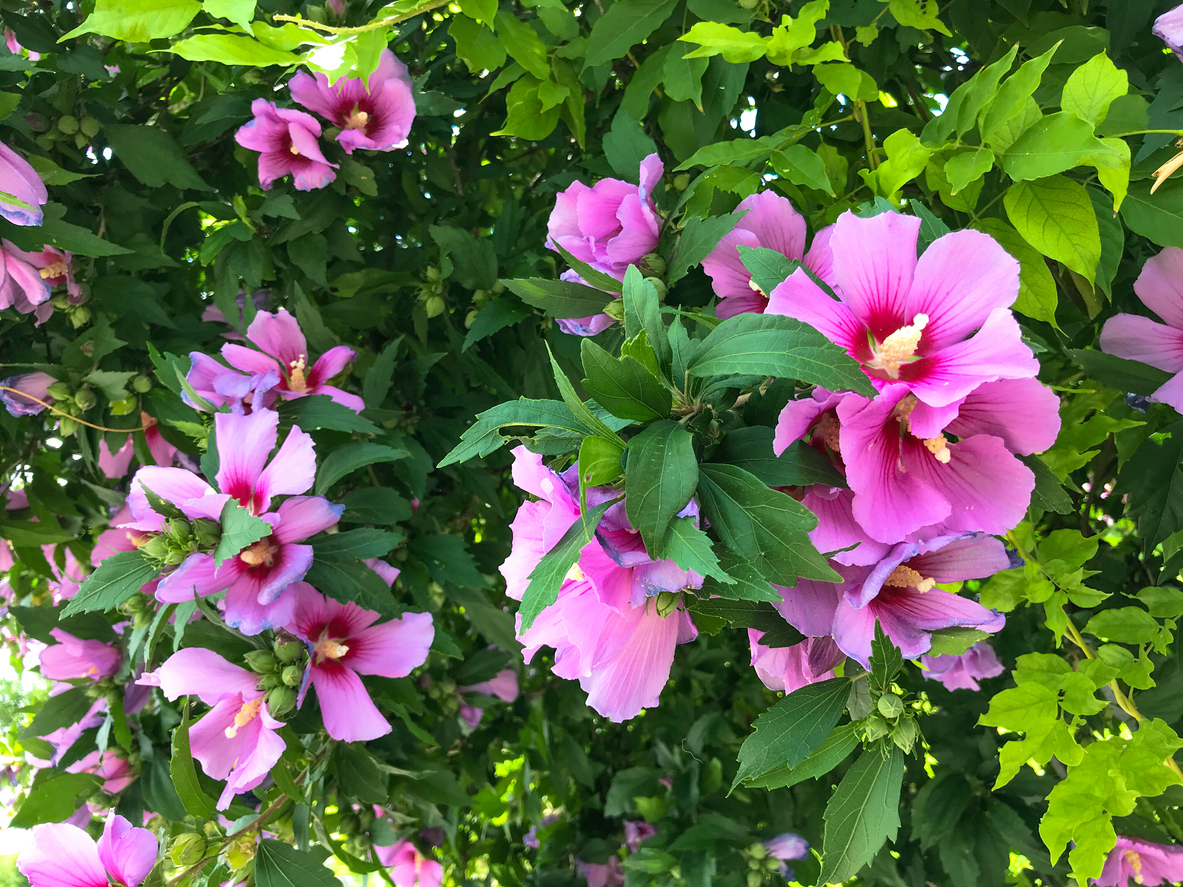
There are lots of varieties of hibiscus plants — 434 different species, to be precise — in the Malvaceae (mallow) family. Other names for hibiscus include roselle, jamaica, red sorrel, and rose mallow.
Most hibiscus plants have white, pink, or red flowers; however, yellow and orange ones are available, too.
The plant is native to warm-temperature, subtropical, and tropical regions throughout the world. Certain varieties can also grow in colder climates, such as New England in the US, and in UK greenhouses.
Hibiscus is a perennial shrub, so if you plant one, you can enjoy its beauty and harvest its flowers and leaves for many years.
Although they’re usually grown as ornamental bushes or shrub borders in residential areas, many parts of the plant are edible.
What Part of Hibiscus Is Edible?
You can eat the hibiscus flower, including its calyx (the bud that protects it), petals, and seeds. The leaves of the plant are also edible.
Hibiscus tea, made from calyces (plural of calyx) and leaves, is used medicinally around the world. If you’re in Mexico, ask for Agua de Jamaica. West Africans know it as bissap, and in Thailand, you can drink nam krachiap.
The flowers and calyces of the hibiscus plant are also frequent ingredients in Mexican cooking.
Hibiscus Nutrition
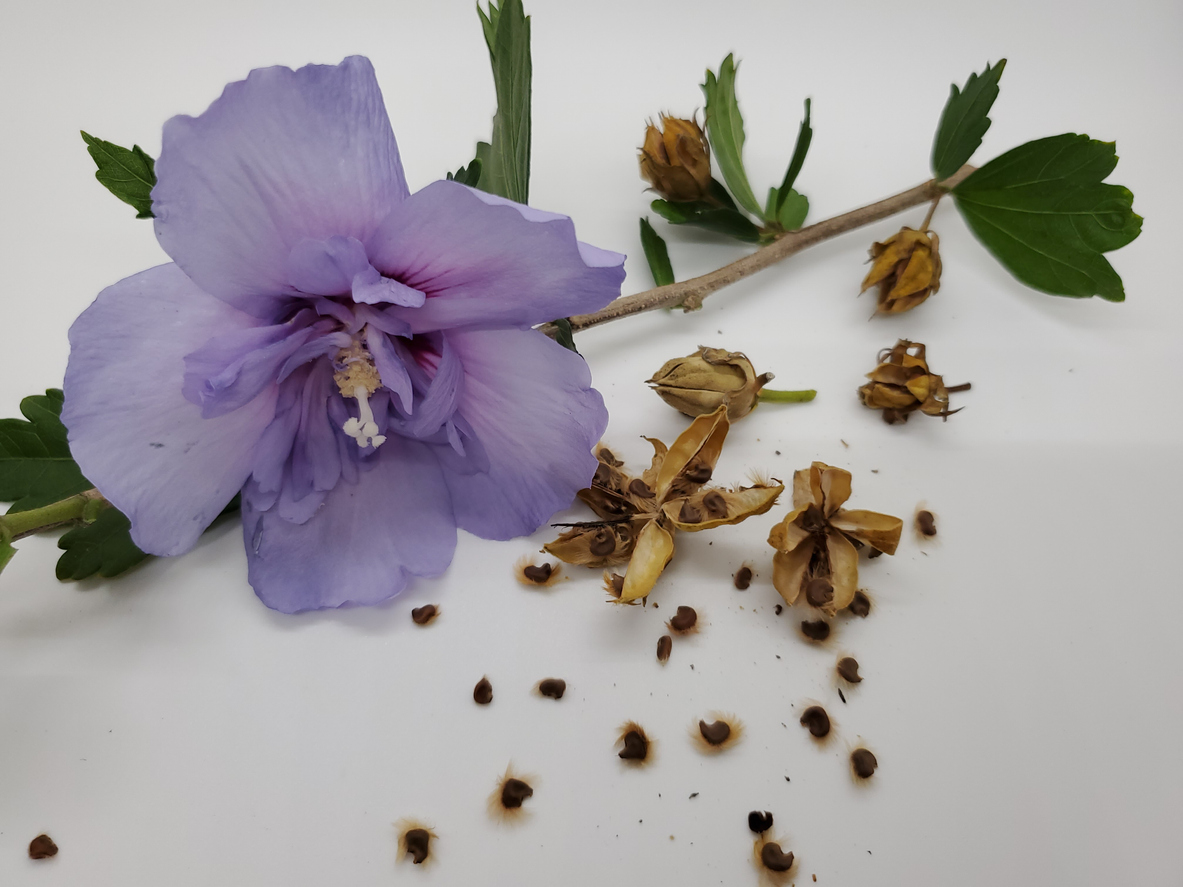
The edible parts of the hibiscus plant — especially the calyces and seeds — are nutritional powerhouses. They’re high in vitamin C, antioxidants, and polyphenols. The red and pink varieties contain anthocyanins. And hibiscus is also high in minerals such as calcium and manganese.
Health Benefits of Hibiscus Tea
Hibiscus offers a wide range of health benefits. Researchers typically use an extract of hibiscus rather than tea in order to precisely control the dosages. These are a few of the health conditions that have been studied in relation to hibiscus in clinical trials.
Hibiscus and Diabetes
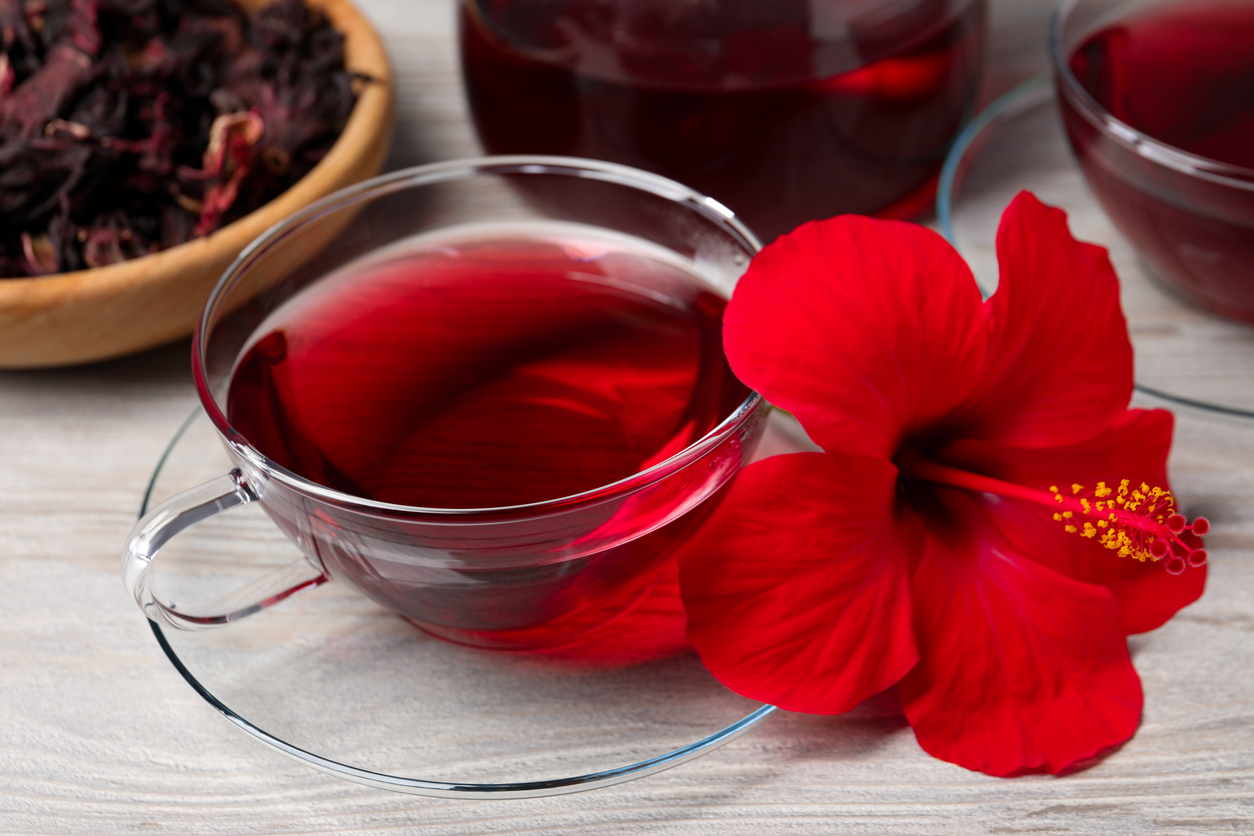
In 2010, researchers in Mexico took a group of people with metabolic syndrome (a condition that’s often a precursor to type 2 diabetes) and gave some of them a daily dose of 100 mg of hibiscus. Those who took the hibiscus powder lowered both their blood glucose levels and their insulin resistance.
Then in 2016, researchers in Nigeria looked at the effect of hibiscus extract on rats with metabolic syndrome (induced by feeding them large quantities of high-fructose corn syrup). Although many metabolic markers were altered initially after the high-fructose diet, the lipids, altered glutathione levels, and DNA damage were restored after the extract was taken.
(I have two tangential thoughts to share here. First, our view on the use of animals in medical research is here. And second, it’s sobering that the same substance used to harm lab rats is also in many processed foods sold to humans.)
Hibiscus and Liver Disease
Hibiscus extract also has been shown to improve liver health.
A 2024 study out of Thailand investigated the effects of hibiscus extract on nonalcoholic fatty liver disease in rats fed a high-fat diet. The hibiscus extract reduced liver fat accumulation and liver damage in the rats.
(Apparently, at least in rats, a high-fat diet is associated with inflammation, oxidative stress, and insulin resistance. And hibiscus extract can help!)
These results echo those of a decade-and-a-half-old human study. In that scenario, adults with fatty liver disease who took hibiscus extract reduced their levels of liver fat (called “liver steatosis”) by about 15%.
Hibiscus and Heart Disease
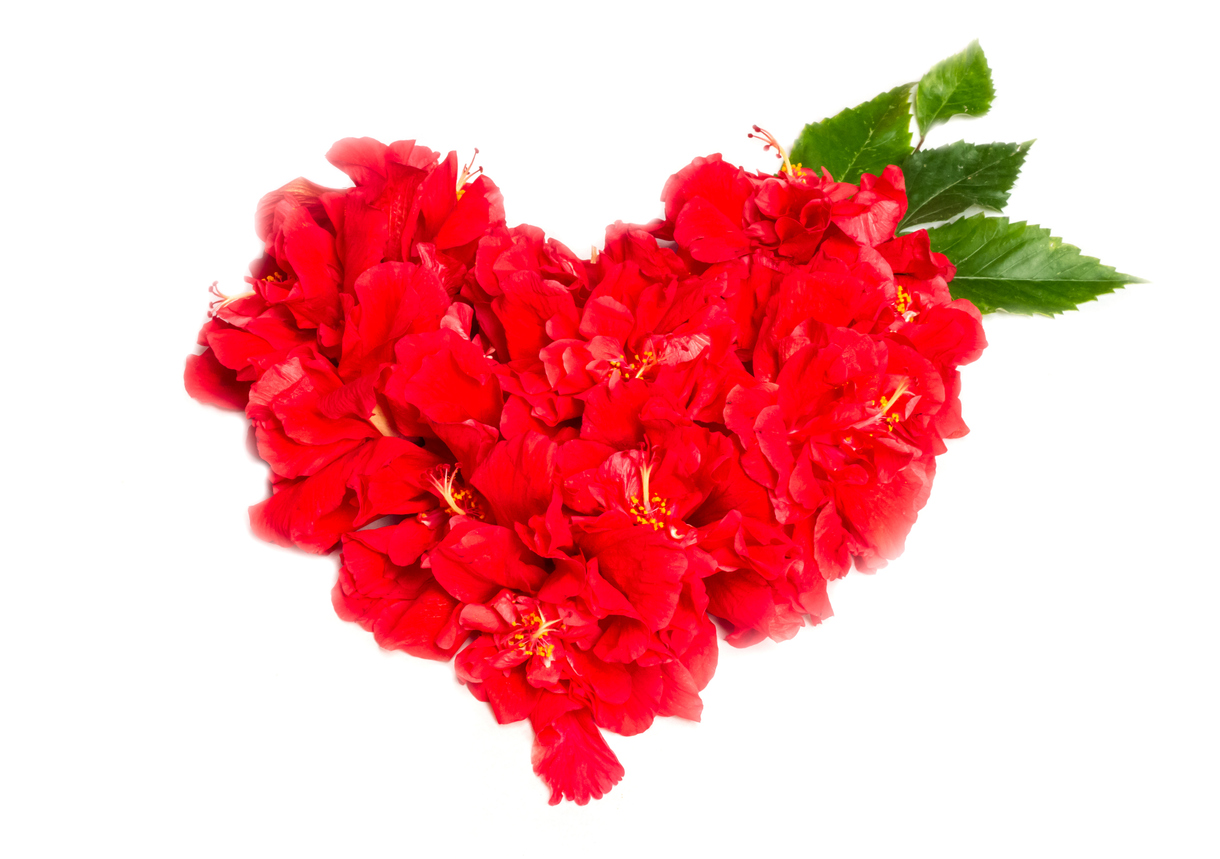
A 2022 review article reported that numerous clinical trials have shown hibiscus consumption can lower high blood pressure, reduce high cholesterol and other blood lipids, and fight inflammation. All three of these conditions are related to heart disease. But unlike pharmaceutical drugs that treat hypertension, high cholesterol, and inflammation, hibiscus teas and extracts haven’t shown any adverse side effects.
A 2022 meta-analysis found statistically significant reductions in blood pressure (especially systolic) and LDL (“bad”) cholesterol in clinical trials involving hibiscus consumption versus placebo.
Researchers from the UK and Nigeria also collaborated on a 2019 study looking at the effects of hibiscus flower calyces on heart health. Men with low to moderate heart disease were given either an aqueous solution of hibiscus calyces or water (the placebo) with a high-fat breakfast. They were then fed a high-fat lunch two hours later. Those men who had the hibiscus calyx extract had increased vascular function, a slight decrease in blood pressure, and improvements in some heart disease risk markers.
A 2023 meta-analysis examined seven studies involving 332 participants and determined that people who took hibiscus extracts had lower blood pressure and cholesterol levels than placebo groups.
Hibiscus for Obesity
In Mexico, hibiscus tea has long been a weight loss aid. Computer modeling based on test-tube study data predicts that some of the compounds found in hibiscus can block the activity of enzymes that digest fat from food and convert it into body fat.
Just as hibiscus can prevent the accumulation of fat in the liver, it appears to do the same elsewhere in the body. A 2019 study found that overweight people who consumed a supplement of hibiscus and lemon verbena for two months experienced significant improvements in body weight, abdominal circumference, and body fat percentage.
A team of Mexican researchers published a paper in 2019 that explored the mechanisms through which hibiscus contributed to weight loss in rats. They found that hibiscus-fed rats pooped out more fat, and their fat cells were less able to grow larger than rats given a placebo.
Hibiscus Antibacterial Benefits

Several different types of hibiscus have antibacterial properties. Researchers in South Korea found that many varieties of Hibiscus acetosella, colloquially known as cranberry hibiscus, showed antibacterial activity against Staphylococcus aureus and Pseudomonas aeruginosa bacteria, both of which are often resistant to pharmaceutical antibiotics.
And Hibiscus sabdariffa, also known as red roselle, showed antimicrobial properties when exposed to various disease-causing bacteria of the oral tract. In fact, the hibiscus performed as well as chlorhexidine, a medical-grade antiseptic used in hospitals for wound care and as a mouthwash to prevent gingivitis.
Side Effects of Hibiscus
With that long list of potential health benefits, you might think that it would be a good idea to chug as much hibiscus tea as possible. But there are a few reasons to exercise caution — or at least moderation.
Hibiscus and Pregnancy or Lactation

For one thing, hibiscus is a mild emmenagogue, which is a word I had not heard of until about 10 minutes ago (clearly, I need to watch more spelling bees). An emmenagogue is a substance that increases blood flow to the pelvic area and can sometimes stimulate menstruation. The US government’s Medline website advises pregnant women to avoid hibiscus tea out of concern that it might increase the likelihood of pregnancy termination.
A 2017 study found that the offspring of female rats who were given hibiscus tea during pregnancy were affected by the tea. Some of the rats already had diabetes, and the tea improved the health of their offspring. But the healthy rats suffered — their HDL (“good”) cholesterol decreased, and they had a higher rate of early pregnancy loss.
Lactating women may also want to avoid hibiscus tea. A 2016 study found that male rats whose mothers were given hibiscus while breastfeeding were affected in a bunch of ways that negatively affected their reproductive health.
Dental Effects of Hibiscus Tea
Hibiscus tea can be highly acidic (like, with a pH under 3, putting it in the same league as Coca-Cola), which means it can affect the pH of your mouth in ways that might wear away tooth enamel. It also contains vitamin C, which is known to contribute to tooth erosion.
On the other hand (or “in the other mouth,” which now that I’ve written, I realize makes no sense), hibiscus tea can also serve as an effective mouthwash thanks to its antimicrobial properties.
So what to do with a beverage that’s good for your mouth and potentially problematic for your teeth? Two strategies come to mind: you can use a straw to bypass your chompers (l like metal ones like these) and/or rinse your mouth with water after drinking hibiscus tea.
Mineral Levels in Hibiscus

Hibiscus tea is high in several minerals, and excessive consumption may lead to increased bodily levels of aluminum, selenium, and manganese.
What constitutes excessive consumption? The World Health Organization advises a 150-pound person not to drink more than 15 cups of hibiscus tea per day.
Dr. Michael Greger, however, suggests limiting consumption to no more than four cups per day, just to be safe. And the small amount of aluminum in hibiscus could be more of a concern if you have impaired kidney function. If that’s the case, you might want to be especially cautious about drinking too much hibiscus tea.
How to Find and Use Hibiscus
So where can you get hibiscus tea? It’s available in most grocery stores — the commonly available Celestial Seasonings teas that have the word “Zinger” in their names all get their “zing” from hibiscus. Specialty markets that feature products of Mexican, Asian, and African origin also are likely sources. And you can find many dried and powdered hibiscus products online.
Increasingly, you can find bottled hibiscus teas and preserves in stores, but these may have added refined sugar and other undesirable ingredients that undermine any health benefits. It may be a good practice to read drink labels closely.
If you’re a gardener, you may be able to grow your own hibiscus for edible purposes, depending on your zone. There are many varieties (including rose of Sharon, hardy hibiscus, and Chinese hibiscus), and one or more may be well suited for your climate and soil.
If you’re harvesting hibiscus flowers or calyces from a bush, try to find one that was grown without pesticides.
In terms of use, you can eat young hibiscus leaves, shoots, and flowers raw in salads. You can also cook them in soups, stews, and curries. You can turn the tart calyces into jams, jellies, and sauces — they’ll set naturally thanks to their high pectin content.
And you can also add hibiscus tea to cocktails, punches, and other drinks.
Hibiscus Recipes
Discover the vibrant flavors and health benefits of hibiscus with our trio of delicious recipes. From the refreshing tartness of Agua de Jamaica to the creamy elegance of Hibiscus Herbed Cheese Crostini, along with the invigorating Strawberry Hibiscus Refresher, these recipes showcase the unique taste and nutritional power of hibiscus flowers. Rich in antioxidants and vitamins, these hibiscus-infused recipes not only please your palate but also support your overall well-being. Enjoy the burst of color, flavor, and health that hibiscus brings to your table!
1. Agua de Jamaica
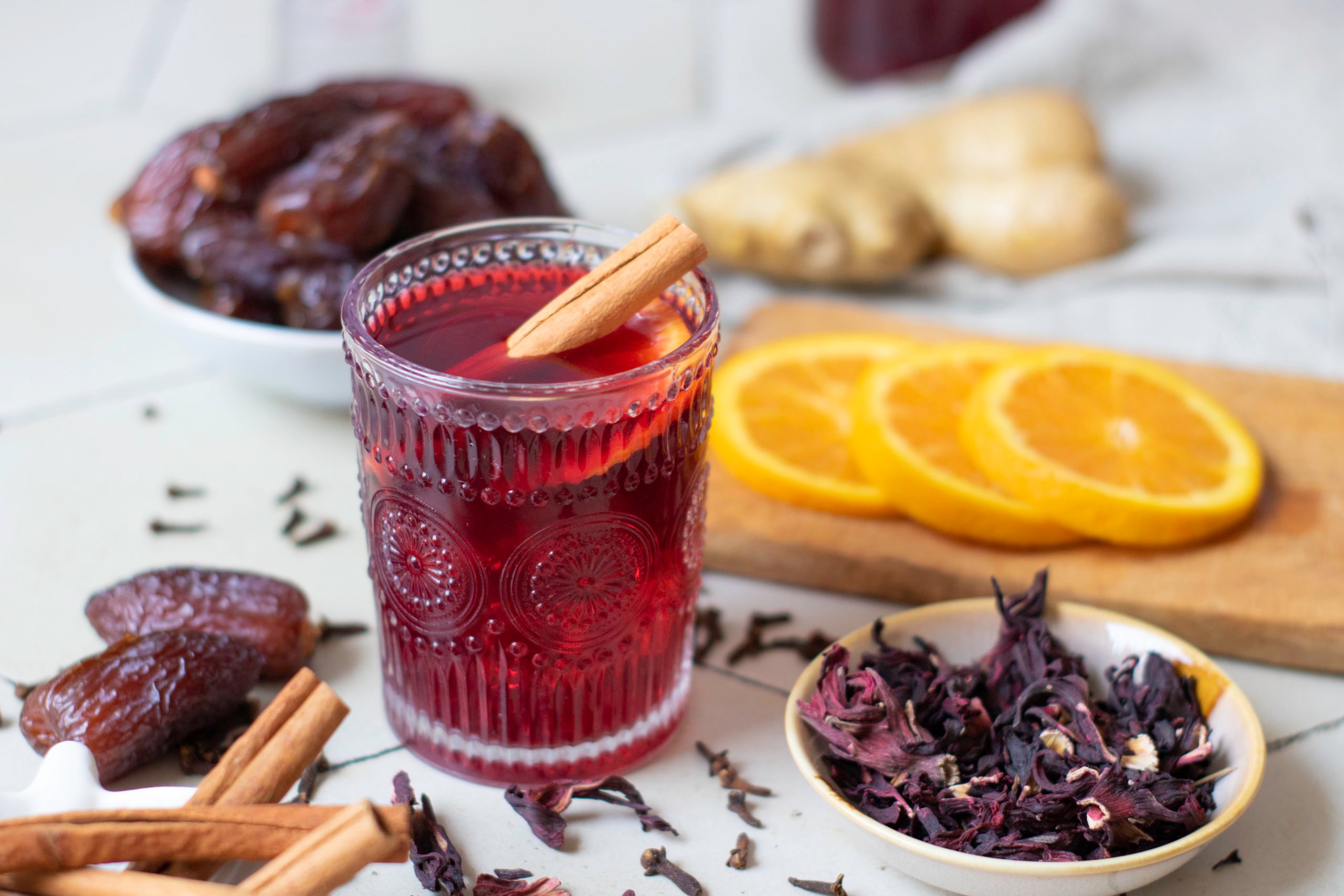 Relish the bold, tart flavor of Agua de Jamaica, a traditional Mexican drink made from dried hibiscus flowers. Steeped in water with cinnamon sticks, fresh ginger, and cloves, this beverage is naturally sweetened with date paste and brightened with a hint of citrus. Refresh yourself with this nutritious and flavorful drink, perfect any time of day, as hibiscus tea is naturally caffeine-free!
Relish the bold, tart flavor of Agua de Jamaica, a traditional Mexican drink made from dried hibiscus flowers. Steeped in water with cinnamon sticks, fresh ginger, and cloves, this beverage is naturally sweetened with date paste and brightened with a hint of citrus. Refresh yourself with this nutritious and flavorful drink, perfect any time of day, as hibiscus tea is naturally caffeine-free!
2. Hibiscus Herbed Cheese Crostini
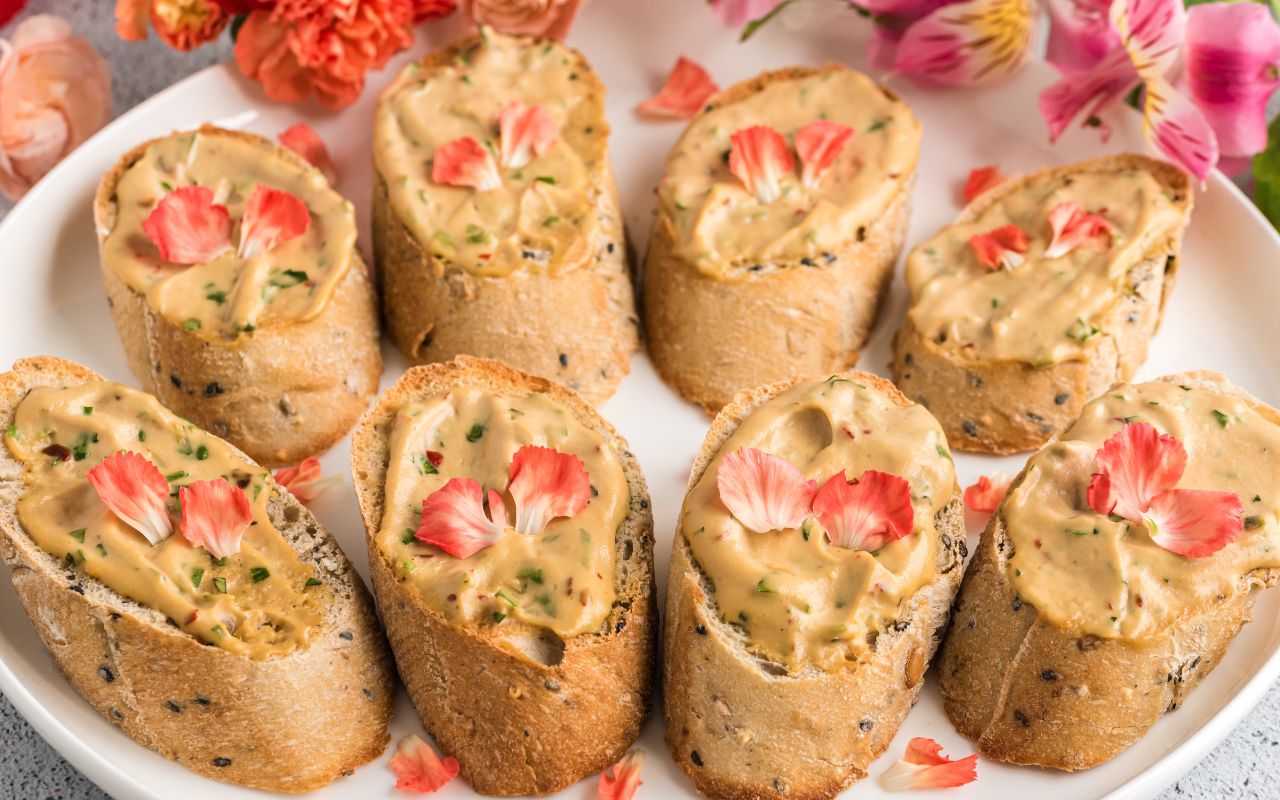
Elevate your appetizer game with our Hibiscus Herbed Cheese Crostini, where the vibrant flavor of hibiscus takes center stage. These delightful tangy bites feature a creamy cashew cheese made with organic miso, nutritional yeast, shallot, and lemon. Fresh herbs like basil, parsley, and chives add a burst of freshness, while red pepper flakes provide a subtle kick. The star of the show, of course, is hibiscus flowers, adding a unique tartness and a beautiful pop of color on top of each slice. Spread this flavorful cheese on slices of organic, whole grain baguette for an impressive and refreshing appetizer. Enjoy!
3. Strawberry Hibiscus Refresher
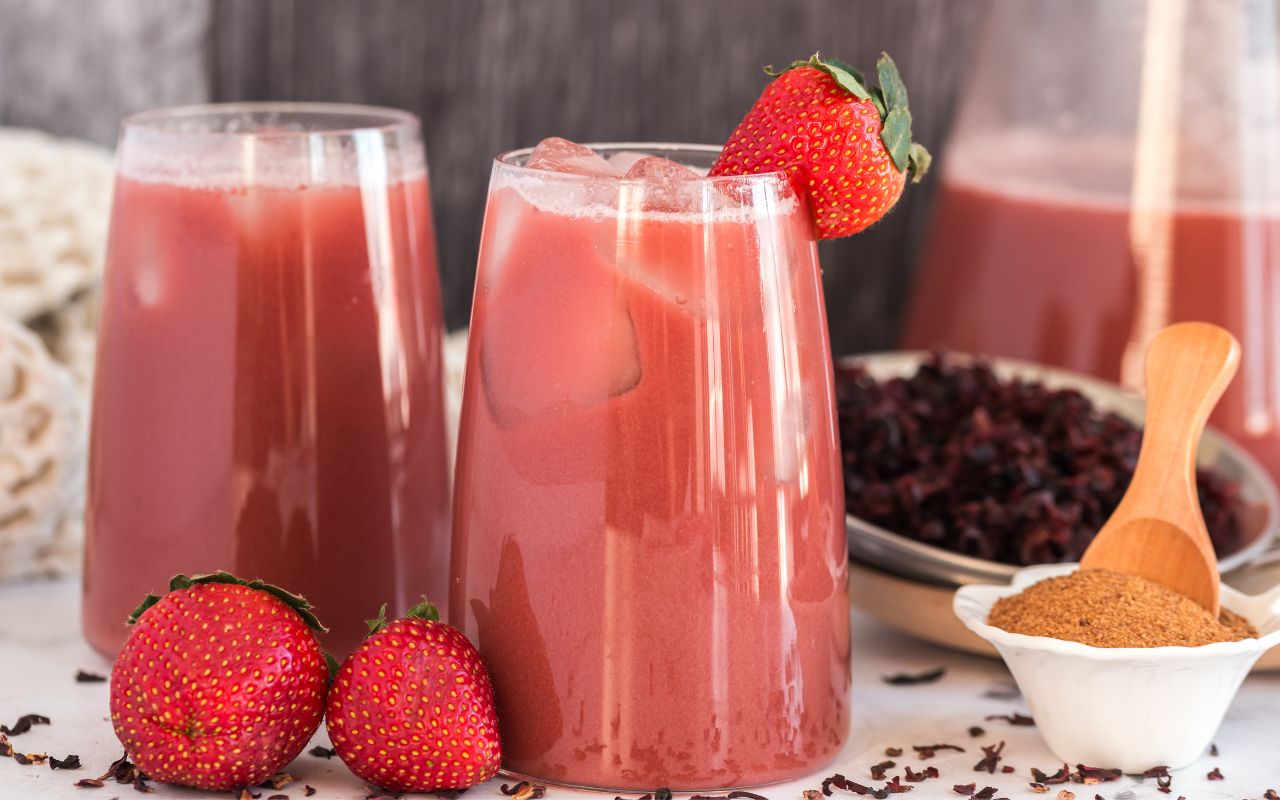
This vibrant drink highlights the bold, tart flavor of hibiscus flowers, steeped to create a fruity concentrate. Combined with pureed strawberries, a hint of coconut sugar for sweetness, and a touch of light coconut milk for creaminess, the Strawberry Hibiscus Refresher is a delightful blend of flavors. Enjoy this cool and refreshing drink anytime you need a moment of relaxation, and let the unique taste of hibiscus brighten your day.
Enjoy the Benefits of Hibiscus!
Hibiscus is an edible flower packed with essential vitamins, minerals, and antioxidants, making it a valuable addition to a health-conscious diet. Regular consumption of hibiscus, especially in tea form, can help to prevent type 2 diabetes and heart disease and be good for liver health and weight management. But because it’s so acidic, it’s a good practice to rinse your mouth with water after drinking hibiscus tea or drink it with a straw to avoid tooth erosion. It’s also best to consume in moderation, or not at all, if you are pregnant, breastfeeding, or have impaired kidney function.
Beyond its striking appearance and impressive health benefits, hibiscus also offers diverse culinary uses, from teas and beverages to salads, jams, and sauces. Hibiscus is an accessible and delicious plant to incorporate into your diet, whether through home gardening, purchasing dried flowers and tea, or experimenting with hibiscus-infused recipes and beverages.
Tell us in the comments:
- Were you aware of hibiscus tea or its health benefits?
- What is your favorite way to enjoy hibiscus?
Featured Image: iStock.com/Liudmila Chernetska



